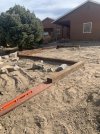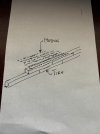pinenutmountainrr
Registered
I’m a new member; I have had G / Garden equipment for 30 years. I built a 15’ x 25’ garden layout 25 years ago, but we moved to rural Nevada and I’m starting a new layout. I hoped to get some insights here on raised RR setups, as I’m not much of a civil engineer (I’m an actual electrical engineer).
My new layout is roughly 42’ x 35’; It is on mostly level desert ground. I’m partially disabled, having a prosthetic leg. Bending over and kneeling is limited, so this railroad is going to be raised. I’ve gone back and forth on how to do walls, how high. My last layout used pre-fab blocks from Home Depot; these are too expensive for this one. I looked at railroad ties initially, but there were cost issues there too. My neighbor builds rock walls from the local rock (which I have tons of), and I started on the first section, but this was going very slowly and I was hurting my hands and back. So I’m back to ties, it turns out I can get them 1/2 price from a tie yard out near the UP line. Right now, I am looking at ~25-30” walls. So far so good, I’m half done with the base layer, and nervous about how well this is going to work.
I’m fortunate in that we get very little rain / snow here, so erosion isn’t a major concern, but I’m trying to use at least reasonable caution for drainage and stability. There is a gravel base under the ties, and as the layers go on, I’m going to pin them with rebar.
Has anyone tried this? I looked for examples here + online and couldn’t find any except for minimum retaining sides here and there.
Thank you for reading!
My new layout is roughly 42’ x 35’; It is on mostly level desert ground. I’m partially disabled, having a prosthetic leg. Bending over and kneeling is limited, so this railroad is going to be raised. I’ve gone back and forth on how to do walls, how high. My last layout used pre-fab blocks from Home Depot; these are too expensive for this one. I looked at railroad ties initially, but there were cost issues there too. My neighbor builds rock walls from the local rock (which I have tons of), and I started on the first section, but this was going very slowly and I was hurting my hands and back. So I’m back to ties, it turns out I can get them 1/2 price from a tie yard out near the UP line. Right now, I am looking at ~25-30” walls. So far so good, I’m half done with the base layer, and nervous about how well this is going to work.
I’m fortunate in that we get very little rain / snow here, so erosion isn’t a major concern, but I’m trying to use at least reasonable caution for drainage and stability. There is a gravel base under the ties, and as the layers go on, I’m going to pin them with rebar.
Has anyone tried this? I looked for examples here + online and couldn’t find any except for minimum retaining sides here and there.
Thank you for reading!



